Post by brianr2 on Feb 9, 2017 10:52:31 GMT
Tangoing in Halifax Part 1:
This is a love story. It describes everything from first glance to courting, to heartbreak, reconciliation and finally consummation. As my romantic tale is quite lengthy I shall split it into several posts, spread - teasingly - over a few days.
In Autumn an old man’s thoughts…
I blame Martin and ocarolan!
Martin is culpable because he organises the Forum’s annual get together in Halifax. Two days in a hotel each September with 30-40 other obsessives, surrounded by guitars, mandolins, other musical instruments and also ... banjos.
Great company, around 100 very high quality guitars to try, expert luthiers with some of the finest examples of their craft, and inspirational performances, all fuelled by alcohol in all its splendid variety. “Kids in a sweetshop” does not begin to describe the extreme temptation involved.
I think "Show of Hands" provide the best advice for those who, like Oscar Wilde and me, can resist anything but temptation:
And the moral of the song, it won’t take long
You might want to write this down
Don’t tempt fat'e, never eat late and keep away from Yeovil Halifax town
O’Carolan hardly helps either. He has set the cruel example of celebrating landmark birthdays with a new guitar. This dangerous precedent resonated with me as I approached (yet) another milestone in my dotage. Then, rather more seriously, a family bereavement underlined for me that no one can take their time here for granted.
Across a crowded room
I had been in a blissfully happy monogamous relationship with my Fylde Alexander. I couldn’t imagine wanting anything else. My wife already complains (fairly) that I lavish more time, attention and care on my Fylde than on her. I am one the few whose answer to the stock question “how many guitars does anyone need”, has always been the heresy: "one should be enough".
Then at the Forum gathering in September, I was drooling quietly over the array of superb guitars on display when I looked at the corner where davewhite had set up camp. Someone was holding one of Dave's guitars which looked as different to mine as a banjo to a bedpan (the latter when used, of course, making the less discordant sound). “Oh”, I thought recklessly, “that looks interesting, I wonder what it's like to play”?
Dave’s “De Faoite” instruments have always intrigued me and I had enjoyed trying several of them at previous Forum get togethers. I thus ambled casually to Dave's corner and picked up the intriguing instrument. It couldn't hurt to try it, could it? The first step on the slippery slope had been taken...
Getting to know you
As soon as I started to play Dave White’s “Buachaill Mór” (“Big Boy”), it just felt perfect. It should never have seemed so natural to me, going from my standard OM to a multi-scale, modified dreadnought, with Manzer-style wedge, side soundport and carbon fibre braces. It not only felt right but sounded wonderful.
I was astonished how much difference the soundport made to what I heard in the hubbub of Halifax. I also loved the multi scale, as someone who almost never plays in standard tuning and is handicapped by stubby fingers and feeble hands. A guitar so different from my Fylde could not be just "one more". Oh dear, casual lust had become love and I was hooked.
A fatherly chat
I then had a long, quiet chat with Dave about my musical interests (gentle fingerstyle in alternate tunings) and guitar preferences (short scale, low action, low tension strings), and that was it. I had succumbed to the Siren's song. Contact details were exchanged, hands shaken and the formal courtship began.
(Internet) Courting is a Pleasure
Dave quickly emailed me a detailed specification to approve, which he has since carefully updated as each detail was finalised. There was thus complete clarity at all times about what I was expecting and what he was making.
The back and sides were to be made from Coyote Wood, Platymiscium polystachyum. This wood comes from South America and is part of the rosewood family (and thus curiously, like all rosewoods, is botanically related to peas and beans). It can be called many other names, including Columbian Rosewood, Macacauba, Amazon Rosewood, Macawood and Guyacana. It was new to me before Dave wrote a piece about it on the Forum – see HERE
Dave gave me the choice (by emailed photos) of five sets of Coyote Wood for the back and sides. This is the one I chose:
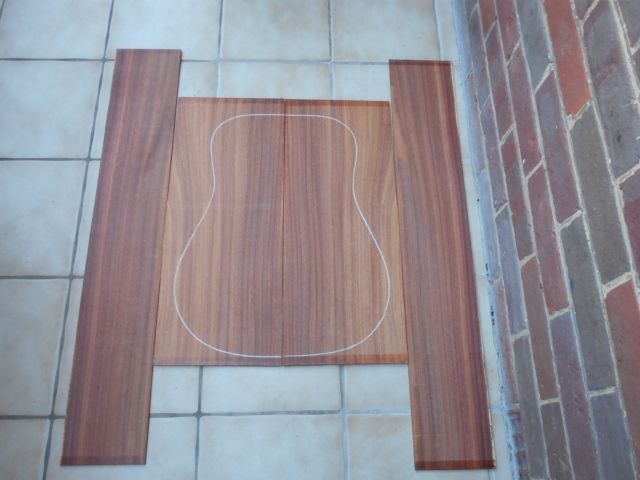
The top would be European Spruce. As a fan of understated style, I opted for black tuners, buttons and strap pins. I wanted something different and similarly understated for fret markers.
The final specification is:
Scale Length: 627-639mm multi-scale
Top: European Spruce
Back and sides: Coyote Wood
Headstock: Solid, Coyote Wood veneer on back and front.
Lower bout width: 395mm
Upper bout width: 300mm
Waist width: 255mm
Overall length: 1,020mm
Maximum rim depth: 125mm Manzer-style wedge
Soundhole/rosette :110mm diameter soundhole. Coyote Wood central ring surrounded by black/white/black (b/w/b) purfling.
Neck: mahogany with scarfe joint and stacked heel, bolt on with 2 way adjustable truss rod and twin carbon fibre rods.
Soundport: side soundport on bass side upper bout.
Tuners: Gotoh black 510’s with oval ebony buttons
Nut/width: bone, 44.5mm.
Saddle/string spacing: two piece bone, 57mm.
Bridge: Macassar ebony with 5° un-slotted ebony bridge pins; slotted bridge.
Fingerboard: Macassar bound with Macassar ebony, b/w/b purfling, 16” radius, bone side/fretboard markers, 21 frets, Jescar FW47104 Gold EVO.
Binding: Macassar ebony with b/w/b purfling on sides, top and back. Macassar ebony end graft with b/w/b purfling. Bubinga heel cap bound with Macassar ebony and b/w/b purfling.
Strap pins: black on the end graft and treble side neck heel.
Finish: hand rubbed pre-catalysed lacquer.
String gauges: 0.012”, 0.016”, 0.020”, 0.028”, 0.038”, 0.051”
Pickup: none.
Serendipity do-dah
I had not previously been enamoured of dreadnoughts. The classic shape did not really work me for some reason. So what had changed my mind? Dave's website includes the following about the modified dreadnought design:
...the relative size of the upper bout to the lower bout will also shape the sound both in terms of box volume and air movement patterns - Dreadnoughts tend to have wider upper bouts in relative to the lower bout. The Modified Dreadnought developed in the 1970's by Ervin Somogyi took the dreadnaught shape, made the waist more pinched and moved the waist and soundhole towards the fretboard to make the instrument more suited to the Wyndham Hill fingerstyle guitarists and their type of sound.
I very much enjoy the music William Ackerman and other guitarists who recorded on his Windham Hill record label, including Robbie Basho, Michael Hedges and Andrew York (for younger readers, records post-dated wax cylinders and pre-dated CDs, which in turn pre-dated computer downloads and streaming). I first discovered this music a few years ago by chance on the Forum and serendipity at Halifax led me to a modified dreadnought. The modifications to the standard made all the difference, notably the narrowed and re-positioned waist, and Manzer-style wedge.
Here endeth Part 1. The next instalment will follow tomorrow. It will chart transformation of the following bits and pieces into a thing of sonic pulchitrude:
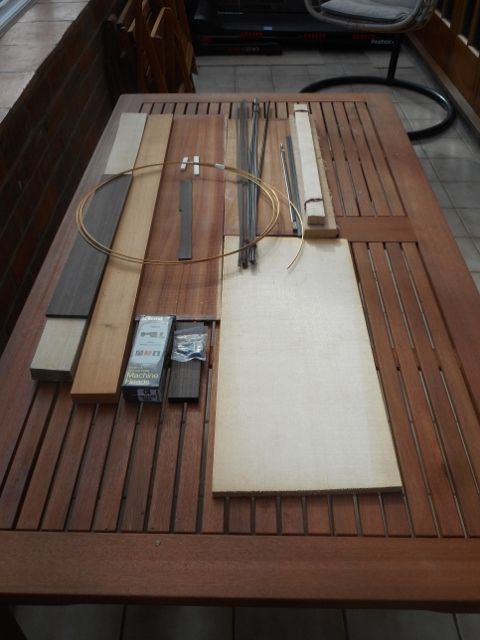
This is a love story. It describes everything from first glance to courting, to heartbreak, reconciliation and finally consummation. As my romantic tale is quite lengthy I shall split it into several posts, spread - teasingly - over a few days.
In Autumn an old man’s thoughts…
I blame Martin and ocarolan!
Martin is culpable because he organises the Forum’s annual get together in Halifax. Two days in a hotel each September with 30-40 other obsessives, surrounded by guitars, mandolins, other musical instruments and also ... banjos.
Great company, around 100 very high quality guitars to try, expert luthiers with some of the finest examples of their craft, and inspirational performances, all fuelled by alcohol in all its splendid variety. “Kids in a sweetshop” does not begin to describe the extreme temptation involved.
I think "Show of Hands" provide the best advice for those who, like Oscar Wilde and me, can resist anything but temptation:
And the moral of the song, it won’t take long
You might want to write this down
Don’t tempt fat'e, never eat late and keep away from Yeovil Halifax town
O’Carolan hardly helps either. He has set the cruel example of celebrating landmark birthdays with a new guitar. This dangerous precedent resonated with me as I approached (yet) another milestone in my dotage. Then, rather more seriously, a family bereavement underlined for me that no one can take their time here for granted.
Across a crowded room
I had been in a blissfully happy monogamous relationship with my Fylde Alexander. I couldn’t imagine wanting anything else. My wife already complains (fairly) that I lavish more time, attention and care on my Fylde than on her. I am one the few whose answer to the stock question “how many guitars does anyone need”, has always been the heresy: "one should be enough".
Then at the Forum gathering in September, I was drooling quietly over the array of superb guitars on display when I looked at the corner where davewhite had set up camp. Someone was holding one of Dave's guitars which looked as different to mine as a banjo to a bedpan (the latter when used, of course, making the less discordant sound). “Oh”, I thought recklessly, “that looks interesting, I wonder what it's like to play”?
Dave’s “De Faoite” instruments have always intrigued me and I had enjoyed trying several of them at previous Forum get togethers. I thus ambled casually to Dave's corner and picked up the intriguing instrument. It couldn't hurt to try it, could it? The first step on the slippery slope had been taken...
Getting to know you
As soon as I started to play Dave White’s “Buachaill Mór” (“Big Boy”), it just felt perfect. It should never have seemed so natural to me, going from my standard OM to a multi-scale, modified dreadnought, with Manzer-style wedge, side soundport and carbon fibre braces. It not only felt right but sounded wonderful.
I was astonished how much difference the soundport made to what I heard in the hubbub of Halifax. I also loved the multi scale, as someone who almost never plays in standard tuning and is handicapped by stubby fingers and feeble hands. A guitar so different from my Fylde could not be just "one more". Oh dear, casual lust had become love and I was hooked.
A fatherly chat
I then had a long, quiet chat with Dave about my musical interests (gentle fingerstyle in alternate tunings) and guitar preferences (short scale, low action, low tension strings), and that was it. I had succumbed to the Siren's song. Contact details were exchanged, hands shaken and the formal courtship began.
(Internet) Courting is a Pleasure
Dave quickly emailed me a detailed specification to approve, which he has since carefully updated as each detail was finalised. There was thus complete clarity at all times about what I was expecting and what he was making.
The back and sides were to be made from Coyote Wood, Platymiscium polystachyum. This wood comes from South America and is part of the rosewood family (and thus curiously, like all rosewoods, is botanically related to peas and beans). It can be called many other names, including Columbian Rosewood, Macacauba, Amazon Rosewood, Macawood and Guyacana. It was new to me before Dave wrote a piece about it on the Forum – see HERE
Dave gave me the choice (by emailed photos) of five sets of Coyote Wood for the back and sides. This is the one I chose:

The top would be European Spruce. As a fan of understated style, I opted for black tuners, buttons and strap pins. I wanted something different and similarly understated for fret markers.
The final specification is:
Scale Length: 627-639mm multi-scale
Top: European Spruce
Back and sides: Coyote Wood
Headstock: Solid, Coyote Wood veneer on back and front.
Lower bout width: 395mm
Upper bout width: 300mm
Waist width: 255mm
Overall length: 1,020mm
Maximum rim depth: 125mm Manzer-style wedge
Soundhole/rosette :110mm diameter soundhole. Coyote Wood central ring surrounded by black/white/black (b/w/b) purfling.
Neck: mahogany with scarfe joint and stacked heel, bolt on with 2 way adjustable truss rod and twin carbon fibre rods.
Soundport: side soundport on bass side upper bout.
Tuners: Gotoh black 510’s with oval ebony buttons
Nut/width: bone, 44.5mm.
Saddle/string spacing: two piece bone, 57mm.
Bridge: Macassar ebony with 5° un-slotted ebony bridge pins; slotted bridge.
Fingerboard: Macassar bound with Macassar ebony, b/w/b purfling, 16” radius, bone side/fretboard markers, 21 frets, Jescar FW47104 Gold EVO.
Binding: Macassar ebony with b/w/b purfling on sides, top and back. Macassar ebony end graft with b/w/b purfling. Bubinga heel cap bound with Macassar ebony and b/w/b purfling.
Strap pins: black on the end graft and treble side neck heel.
Finish: hand rubbed pre-catalysed lacquer.
String gauges: 0.012”, 0.016”, 0.020”, 0.028”, 0.038”, 0.051”
Pickup: none.
Serendipity do-dah
I had not previously been enamoured of dreadnoughts. The classic shape did not really work me for some reason. So what had changed my mind? Dave's website includes the following about the modified dreadnought design:
...the relative size of the upper bout to the lower bout will also shape the sound both in terms of box volume and air movement patterns - Dreadnoughts tend to have wider upper bouts in relative to the lower bout. The Modified Dreadnought developed in the 1970's by Ervin Somogyi took the dreadnaught shape, made the waist more pinched and moved the waist and soundhole towards the fretboard to make the instrument more suited to the Wyndham Hill fingerstyle guitarists and their type of sound.
I very much enjoy the music William Ackerman and other guitarists who recorded on his Windham Hill record label, including Robbie Basho, Michael Hedges and Andrew York (for younger readers, records post-dated wax cylinders and pre-dated CDs, which in turn pre-dated computer downloads and streaming). I first discovered this music a few years ago by chance on the Forum and serendipity at Halifax led me to a modified dreadnought. The modifications to the standard made all the difference, notably the narrowed and re-positioned waist, and Manzer-style wedge.
Here endeth Part 1. The next instalment will follow tomorrow. It will chart transformation of the following bits and pieces into a thing of sonic pulchitrude:



















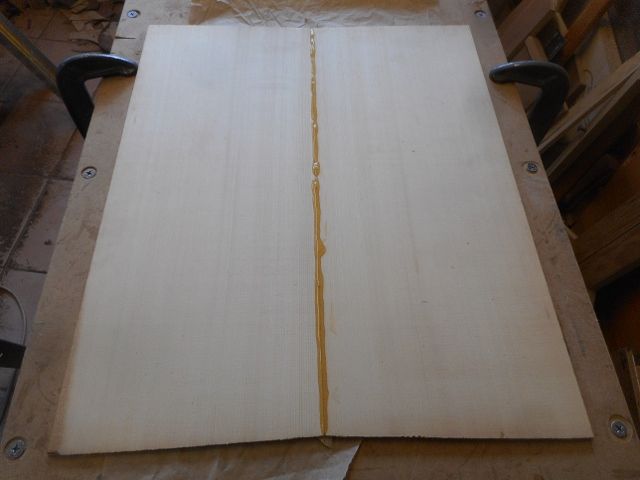



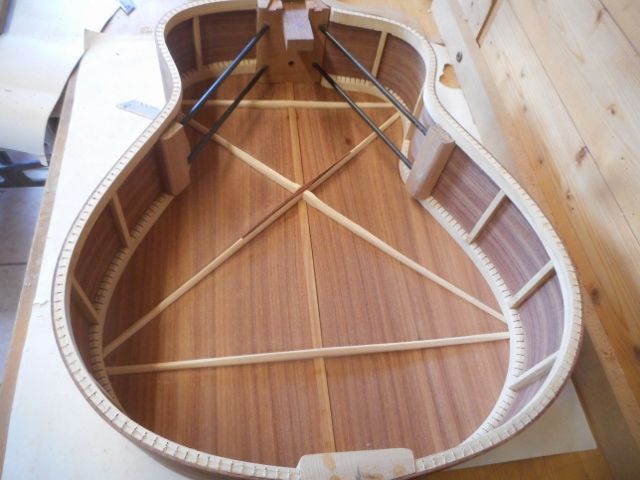

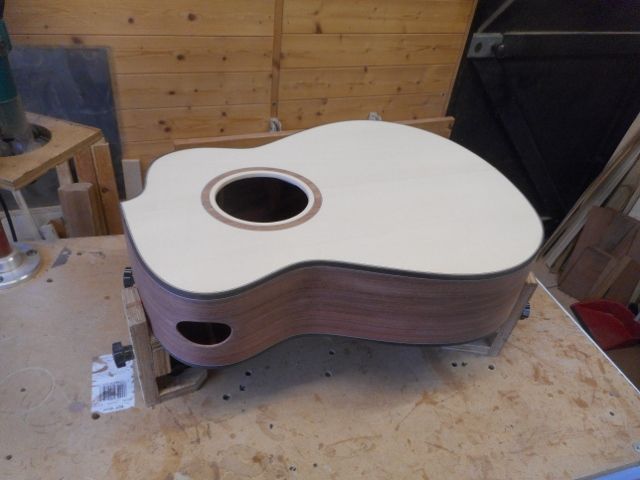






 Jo whoever he is.
Jo whoever he is.
